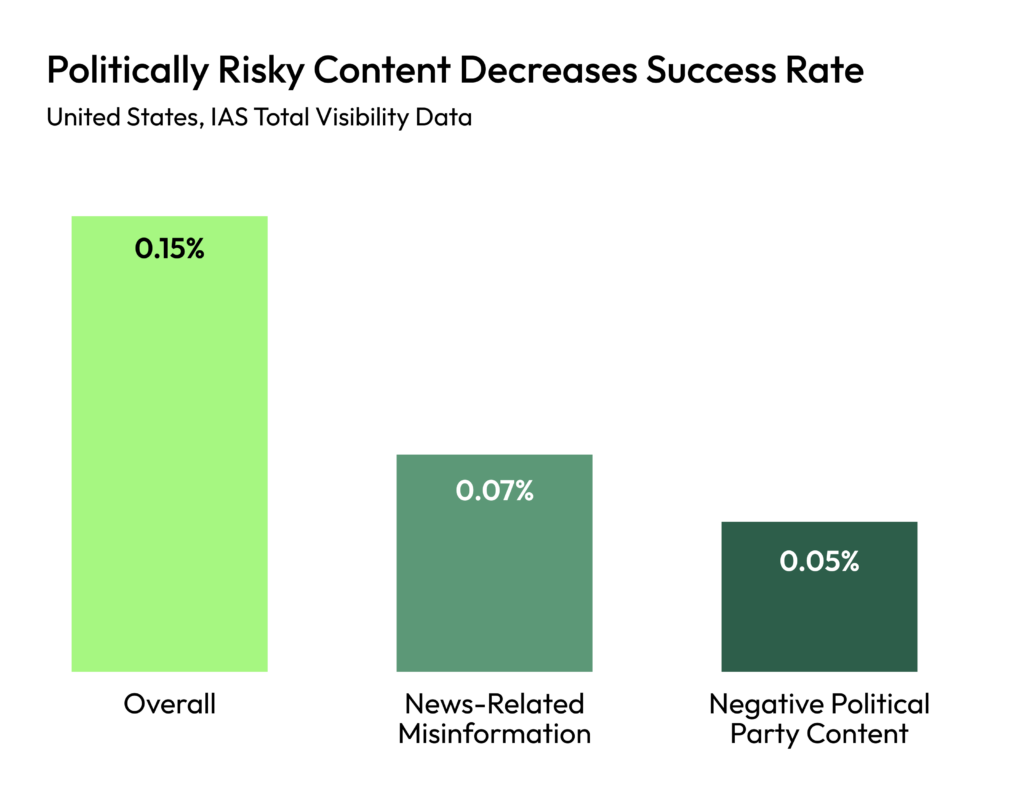Though November 5 is months away, the 2024 United States presidential election cycle and surrounding news coverage has already begun. With more than 15 states holding primary elections on March 5, Super Tuesday provided an early opportunity to explore digital advertising opportunities and risks that the industry may face throughout this election year.
The IAS Election Lab examined traffic volume for high risk political content surrounding these primaries, including controversial political party content and news-related misinformation, and investigated how ad adjacency to this content impacts business results for advertisers.
Negative political party traffic rose around Super Tuesday and other politically-related events
Advertising adjacent to negative news or sentiments surrounding Democratic or Republican political parties is a growing risk for brands. So how is negative sentiment defined?
- Sentiment refers to whether an article conveys a positive, neutral, or negative tone to the consumer reading it
- “Negative” sentiment means a page conveys a negative tone, but does not indicate if the page is brand safe
After tracking the volume of negative sentiment political party impression traffic throughout Q1 2024, the IAS Election Lab found that traffic spiked in tandem with salient political events — including Super Tuesday.

The first spike in traffic volume (up to 0.26%) centered around February 19, more than doubling the Q1 baseline rate (0.12%) in the midst of high-profile civil fraud trials in New York. Around this time, there was a sharp increase in content that included negative sentiments toward both political parties — for example, stories that reported low opinions of the current president or stories that compared a previous president to authoritarian dictators.
A second spike in negative political party traffic volume occurred on March 5, also known as Super Tuesday — more than doubling the baseline rate up to .25%.
During the 2020 presidential election, IAS observed that more than three in four consumers believed online advertising would play an important role in determining the outcome of the election. Avoiding negative political party content and news-related misinformation surrounding elections is especially important for brands aiming to protect themselves from being seen as endorsing a specific political agenda, which could harm brand reputation.
News-related misinformation traffic also spiked around Super Tuesday
Misinformation is an ever-present concern in digital media, but high-profile election cycles can increase a brand’s risk of ad adjacency to misinformation. This year, 59% of media experts expect the U.S. presidential election to create additional advertising challenges surrounding misinformation and fake news.
News-related misinformation appears to rise in conjunction with high-profile news events. This year, traffic peaked two days before Super Tuesday, marking a threefold increase compared to the Q1 volume rate.

Since traffic to news-related misinformation is generally low (representing only 0.001% of all impressions served in Q1 2024), avoiding this content can protect advertisers from this high to medium risk content without hurting scale.
As IAS observed in 2022, brands can build consumer favorability and trust by detecting and avoiding placing ads adjacent to misinformation. Through IAS’s partnership with the Global Disinformation Index (GDI), advertisers can use IAS Brand Safety and Suitability capabilities across open web and social media to detect and avoid misinformation. And with tools like IAS Context Control Avoidance, advertisers can prevent ads from being placed alongside selected risky content while simultaneously protecting scale.
Contextual Avoidance Segments protect campaign results
Beyond protecting your brand, avoiding politically risky content can protect marketers’ bottom lines too. After all, consumers are less likely to engage with or purchase products from ads that are placed alongside misinformation or other risky content.
Using IAS data enriched with performance and cost metrics, we examined the impact of politically risky content on success rate (defined as clicks or conversions) and cost per conversion compared to overall impressions served in the U.S. during the week of Super Tuesday.
Ads adjacent to risky political party content had a 66% lower success rate and a 29% higher, or $0.82 increase, in cost per conversion. Similarly, ads adjacent to news-related misinformation had a 53% lower success rate and an 8% higher, or $0.23 increase, in cost per conversion.


How IAS can help
IAS offers Context Control Avoidance segments to help advertisers avoid placing their ads alongside negative or risky content beyond the GARM categories. Before a bid is placed, IAS’s predictive science pre-screens pages to filter out tailored content that isn’t suitable for your brand.
Contextual avoidance segments like “Politics-GOP,” “Politics-Democrat,” “Misinformation-News,” or other delicate subjects help marketers control where their brand is seen, which can be especially crucial with growing uncertainty of the upcoming election cycle. These avoidance segments protect brand safety without harming scale so you can continue to drive superior results throughout an election year and beyond.
In addition, we recently announced the expansion of our Brand Safety and Suitability Measurement capability to now include the Global Alliance for Responsible Media (GARM) category of misinformation for leading social platforms, like Meta. Advertisers can now review when their ads run alongside content on the subject of misinformation on the feed, in addition to open web.
For a step-by-step guide to scaling your brand in an election year, download your copy of the IAS Political Guide, and explore our IAS Election Lab for more insights.
 Share on LinkedIn
Share on LinkedIn Share on X
Share on X

